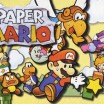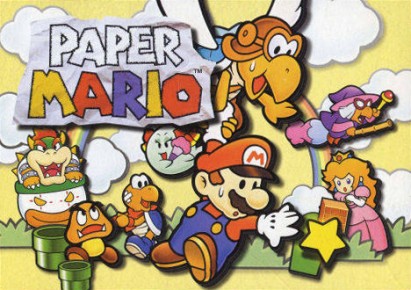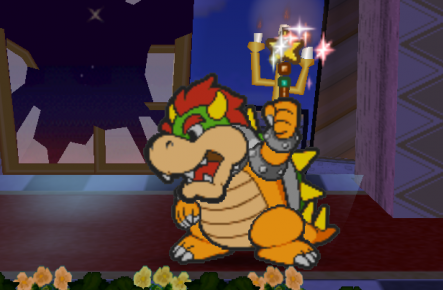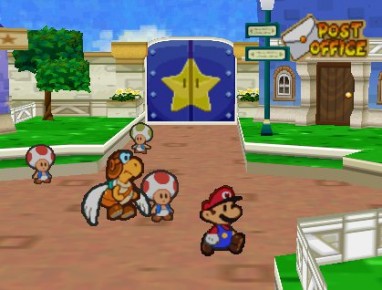Nostalgia Fever: Paper Mario

If there’s anything about Nintendo, they know how to make games, no matter their genre. There’s Zelda for puzzling adventures, Pokemon for collecting and roleplaying, Star Fox for space shooting, and Mario for just about everything. Mario games are addicting in both their simplicity to understand and the rewarding mastery. And because Mario games have so many different genres to offer, they’re all fun and engaging. I’m especially fond of their RPGs, like Paper Mario.
The story begins as you’d expect most Mario stories nowadays; Mario is minding his own business, enjoying the peaceful days of the Mushroom Kingdom, but just as he’s having alone time with Princess Peach, Bowser crashes the party, lifts Peach’s castle up to the air, and battles Mario. Playing as the titular plumber in your first fight in the game, you have only 10 Heart Points, access to only one attack (the signature Jump) and Bowser… he suddenly brandishes the Star Rod. Had you watched the intro preview before the start screen, you’d know he stole this artifact from the Star Spirits, and it has the power to grant wishes. Uh oh.
So by giving himself invulnerability, Bowser easily trounces Mario before blasting him spiraling to the ground. This would have been the end, but the Seven Star Spirits use their last bit of energy to revive Mario, who is then rescued by a family of nice Goombas. What are the odds?
After traveling back to the Mushroom Kingdom with your trusty Goomba guide Goombario (and going through some rudimentary tutorials of how to play through your adventure), you are soon told by the Star Spirits of Bowser’s actions. Mario’s quest is clear; to save Princess Peach and make sure everyone gets their wishes, you must find all Seven Star Spirits that Bowser has captured and hid in all the corners of the world.
The plot of Paper Mario is actually similar to an old SNES game Super Mario RPG: Legend of the Seven Stars, but with the big difference that Bowser is the villain instead of a playable character. Other similarities come up such as the witty jokes sprinkled around and lots of sidequests to make the adventure more fun. This is added to the fact that everyone is as thin as a piece of paper; in two separate moments where Mario falls from somewhere high, he lands by swaying through the air like a feather.
Gameplay borrows back to Super Mario RPG that you have to time your attacks at the right moment for maximum damage. Paper Mario is more gracious to show a picture of the button action needed and help time you for the best results, and tells you when you got it right (“Nice!”). As Mario, you equip badges that increase certain stats or give you new attack commands (like a Power Jump or Hammer Throw). Badges themselves are valuable to find and collect, and use up Flower Points. And for each Star Spirit saved throughout the game, you get an increased Star Meter and a new ability to use through said Star gauge. For example, the first spirit you rescue, Elstar, gives you a light recovery of 5 HP and 5 FP. It’s very useful early in the game, but not so much later on.
You can also use one partner (each representing a classical Mario enemy) to back you up with their own special attacks (also costing FP outside of their basic attacks). Mario’s the only one that takes damage, but if the partner also gets hit (which is still rare) they can’t move or act for as many turns as the damage dealt (2 HP = 2 inactive turns). Each character has their own variety of skills to use, like Goombario’s Tattle that reveals to you the HP of your enemy, a little background info, and strategies in fighting them. These skills also come in handy in exploring the world, from hitting a switch at a distance or flying over a gap too far to jump across.
Back to the story at hand, you explore a lot of places in the Mario world, and might find secrets hiding in corners, like Super Blocks that can upgrade a party member’s rank for a new skill, or Star Pieces that can be traded for exclusive badges. There’s also the mail carrier side quest where you find lost letters from your clumsy mail-man Parakarry. To recruit him and move on with the story, you have to find 3 letters he dropped in the area. He reluctantly admits afterward that there were more letters dropped so he joins you to find them. He’ll personally deliver letters to the mail recipient when selected as a party member, and you’re paid a Star Piece for your troubles. Speaking of mail, you can also read letters to Mario in his house, or letters to the party members
Paper Mario proves to be so successful that it spawned a whole sub series of games, and was put up for digital download on the Wii console. Paper Mario the Thousand Year Door for the Gamecube is a beautifully stylized sequel that makes full use of the paper-like environment, while Super Paper Mario for the Wii is more adventure and less RPG. There’s also Paper Mario: Super Sticker Saga for the 3DS but I don’t have the system to play it.
Anyway, Paper Mario is a great game. The adventure is long, expansive, and fully rewarding. Whether its some side boss for bragging rights or fighting a chapter boss to save a Star Spirit, it feels just awesome to be a bit more like the Mushroom Kingdom hero himself, and see as he levels up and up to face more adversaries. It’s also cool to see games where Bowser is more of a powerful adversary and not merely comic relief as he’s become in other Mario RPG games. Here he shows an interesting balance of bumbling fool and deadly foe that fits right in old Saturday morning cartoons. I implore readers to give this game a chance, for it’s one of the best Mario games out there.








![[PROTOTYPE]](http://www.enthusiacs.com/wp-content/uploads/2020/03/title-104x104.jpg)


Leave a Reply